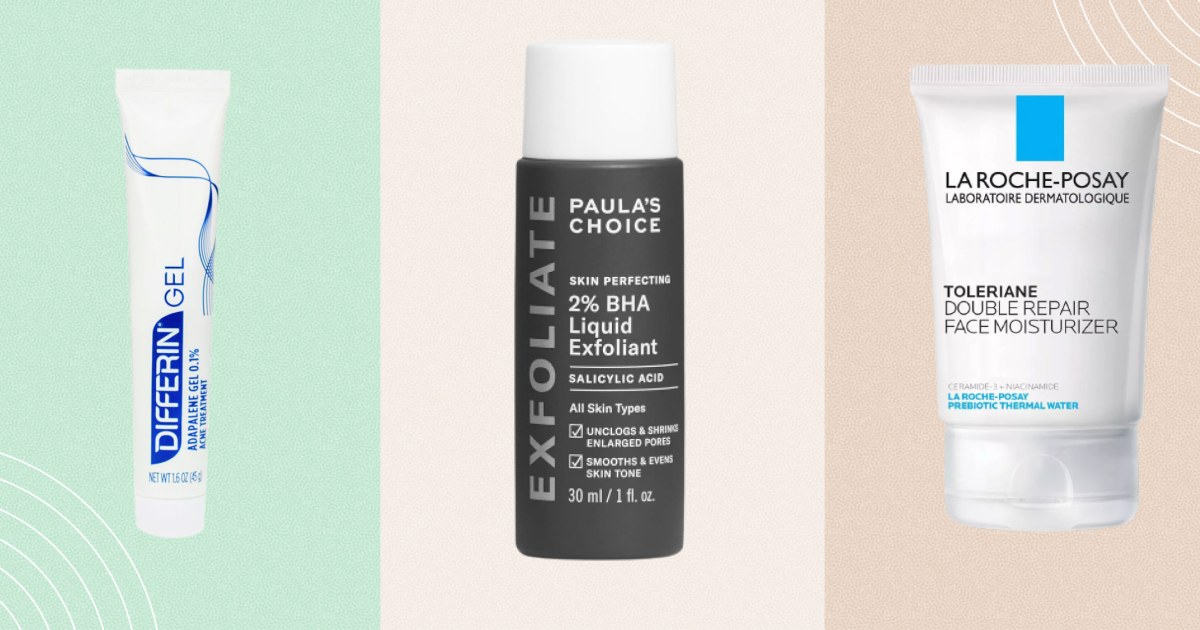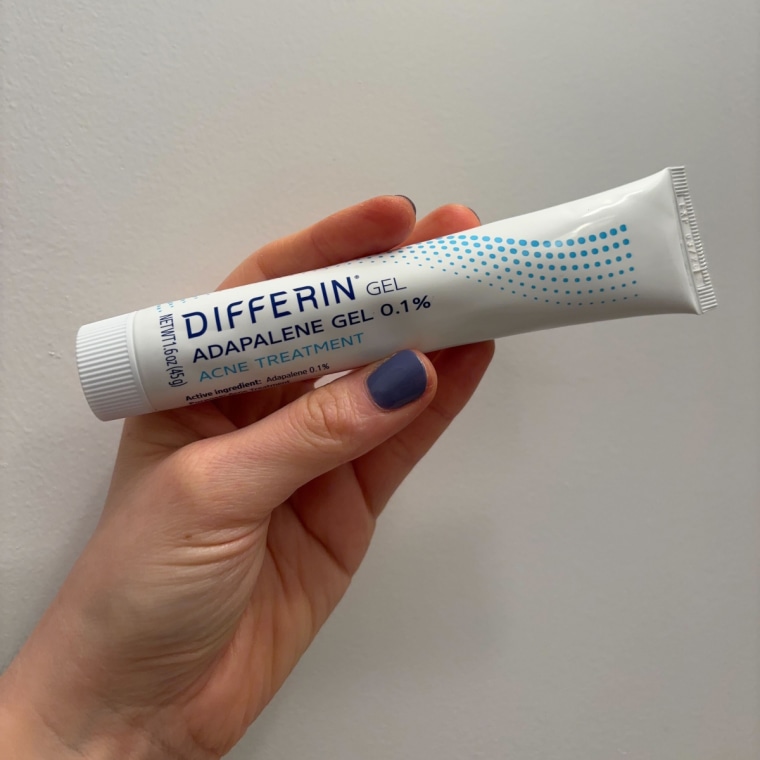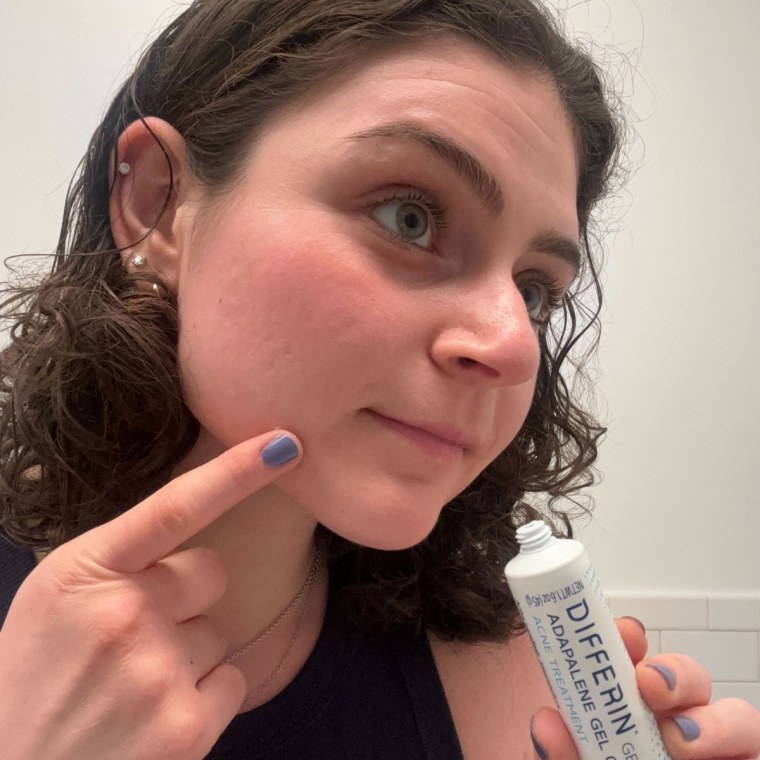


Though we usually associate acne-prone skin with the more annoying parts of our teenage years, it has become more common in adults. It’s also a bigger issue among women: Approximately 22% of women in the U.S. suffer from adult acne compared to just 3% of men, according to a 2014 study in The Journal of Clinical and Aesthetic Dermatology.
SKIP AHEAD The best products for acne-prone skin | What are the best ingredients for acne-prone skin? | What to know when buying products for acne-prone skin | What causes acne? | Why trust NBC Select?
Depending on the severity of your condition, controlling acne can be difficult — but it’s not impossible. I spoke to board-certified dermatologists about the skin care ingredients that can help clear up acne, inflammation and dark spots. I also compiled some of their recommendations for you to shop.
The dermatologists I spoke to recommend products with acne-fighting ingredients like salicylic acid, benzoyl peroxide, adapalene and azelaic acid (more on that below). Below are the best face washes, moisturizers, sunscreens and treatments that feature these ingredients as well as other expert-recommended acne-fighting ingredients like niacinamide and zinc oxide. Products tested by NBC Select staffers are also included.
Dr. Eileen Deignan, a board-certified dermatologist and chief of dermatology at Emerson Hospital, recommends this salicylic acid cleanser from expert-favorite brand Neutrogena to clean out pores and calm acne. It has LHA (lipohydroxy acid), which is recommended by Dr. Emmy Graber, a board-certified dermatologist and president of The Dermatology Institute of Boston, as a more gentle acne solution. It’s suitable for most skin types since it’s free of oils, fragrances and parabens, according to the brand.
Formula: Liquid
CeraVe — a popular brand among our experts — is Deignan’s pick for a lower-strength benzoyl peroxide wash. It features a 4% benzoyl peroxide concentration to help clear acne, hyaluronic acid to help retain the skin’s natural moisture and niacinamide for a natural anti-inflammatory effect, according to Deignan.
Formula: Cream
This fragrance-free acne face wash from expert-favorite brand La Roche-Posay contains a 2% concentration of salicylic acid. Dr. Tracy Evans, a board-certified dermatologist and medical director of Pacific Skin and Cosmetic Dermatology, says the brand combines the ingredient with LHA to “balance the cleanser” and make it gentler on the skin. It also contains glycerin, which Stevenson tells us is a type of AHA that hydrates and helps soothe the skin.
Because of its drying element, Evans says this face wash can be a good option for people with oily skin — for more sensitive skin types, she recommends the brand’s Toleriane Hydrating Gentle Cleanser since it’s less stripping, has niacinamide and “provides hydration along with cleansing the skin.”
Formula: Gel

Dr. Caren Campbell, a California-based board-certified dermatologist, recommends this OTC retinoid in our guide to retinol. Experts told us that retinoids promote skin cell turnover and cure inflammation to deep clean pores and prevent new pimples from forming. NBC Select associate updates editor Zoe Malin says that before she was prescribed acne medication, Differin was her main treatment. After some initial dryness and redness, her skin built up a tolerance to it — “during the time I consistently used Differin, I saw a dramatic change in my acne. I broke out less and my blemishes were smaller and less painful,” she says. After you cleanse, tone and moisturize, apply a thin layer of the gel treatment to the affected areas of the skin, says the brand.
Formula: Gel

This liquid leave-on exfoliant from Paula’s Choice contains 2% salicylic acid to help remove dead skin cells and unclog pores. It’s been part of NBC select associate SEO reporter Ashley Morris’ skin care routine for years — “texture is never a problem for me while using this because it clears up breakouts so fast, they barely have time to fully form.” It also has green tea, which the brand says can help soothe irritated skin and improve fine lines.
Formula: Liquid
This face mask from Mario Badescu contains sulfur, “the oldest known ingredient to help with skin inflammation,” according to Graber. The combination of sulfur and zinc oxide in this mask draws out impurities and gets rid of excess oil, while calamine and cucumber can cool the skin and ensure you don’t feel irritated afterward, says Mario Badescu. You can apply it either two or three times a week — it can also be used as a spot treatment on stubborn breakouts, according to the brand.
Formula: Cream
La Roche-Posay’s Effaclar Adapalene Gel — another recommendation from Campbell — also contains 0.1% adapalene to unclog pores and fight blackheads and whiteheads, the brand says. La Roche-Posay’s gel is also slightly gentler and more moisturizing than the Differin gel, according to people who have used both.
Formula: Gel
Graber recommends this product from Neutrogena, which contains 3.5% benzoyl peroxide. It can be used as a daily cleanser or weekly mask to kill bacteria and prevent future breakouts, according to the brand. It’s formulated with kaolin and bentonite clay, both of which are oil-absorbing ingredients.
Formula: Clay
Graber says she usually recommends The Ordinary Azelaic Acid Serum to her patients since it can help improve both blemishes and dark spots. The serum, which contains 10% azelaic acid to help brighten your complexion, is cruelty-free, vegan and gentle enough to use up to twice a day, according to the brand. Morris, who’s used this cream treatment in the past, says that it brightens her complexion.
Formula: Cream
“Products that offer hydration and are oil-free can be very helpful for acne, such as a CeraVe everyday moisturizer,” says Evans. This oil-free nighttime moisturizer from the brand features niacinamide, hyaluronic acid and other ceramides to provide essential moisture throughout the night, according to the brand. You can also get the brand’s AM Facial Moisturizing Lotion, which has SPF 30.
Formula: Lotion
Dr. Lindsey Bordone, a board-certified dermatologist and assistant professor of dermatology at Columbia University Medical Center, tells us Cetaphil is a trustworthy brand for those dealing with acne. This face and body moisturizer from the brand features a non-greasy, paraben-free formula with no added fragrance to avoid irritation for sensitive skin types, according to the brand. Cetaphil says the moisturizer can provide up to 24 hours of hydration, and it comes in four sizes ranging from 4 ounces to 20 ounces.
Formula: Lotion
Board-certified dermatologist Dr. Erum Ilyas previously recommended this face moisturizer from La Roche-Posay due to its soothing and hydrating properties. The brand says the moisturizer offers 48-hour hydration and can be used on the face, neck and hands.
Formula: Lotion
This balm is the second place winner in our 100 moisturizers ranking — and a favorite of our editors. Malin applies this balm every night and says it revives her skin from the dryness left behind by tretinoin treatments. “It’s super thick and creamy, and feels so luxurious on my skin, plus it never stings or causes irritation.”
Formula: Balm
The EltaMD UV Clear Sunscreen is a favorite of Deignan’s since it’s free of heavy moisturizers that could clog pores and contains the natural anti-inflammatory ingredient niacinamide. EltaMD’s mineral-based sunscreen offers SPF 46 and includes zinc oxide, which experts previously told us provides protection against the sun’s UVA and UVB rays while soothing the skin. For those with dark spots or discoloration, our experts also recommend EltaMD’s tinted version of this product as one of their favorite tinted sunscreens.
Formula: Lotion
Although Malin loves many of Supergoop’s sunscreens, she says this one in particular is “fantastic for warm weather and constant reapplication,” which is especially important for her since prescription acne medication makes her skin more sensitive to the sun. “It blends into my skin and dries in seconds, plus never makes me look shiny — I forget I’m wearing sunscreen after I put it on,” she says. The sunscreen is lightweight, has a natural finish, and can also double as a makeup primer, according to the brand.
Formula: Lotion
The dermatologists we spoke to highlight four key ingredients to help fight acne: salicylic acid, benzoyl peroxide, adapalene and azelaic acid. These are available as prescriptions for more stubborn acne, but there are plenty of over-the-counter products that offer these ingredients at a lower dosage.
Other acne-fighting ingredients found in OTC products include alpha hydroxy acids (AHA) and beta hydroxy acids (BHA). These compounds can “help with clogged pores like blackheads and can cause the top layer of dead skin cells to shed,” according to Dr. Mary Stevenson, a board-certified dermatologist and associate professor at NYU Langone Health’s Department of Dermatology. However, experts agree you should consult your dermatologist to see what works best for your skin and won’t cause irritation (or worsen your acne).
Salicylic acid is a BHA, which means it’s a chemical exfoliator. The compound “helps shed the top, dead layers of our skin and can help with inflammation,” says Stevenson. These products, typically in the form of a cream, wash or lotion, “unclog pores that are the cause of some acne lesions and help to remove excess oils,” according to Deignan. Since it can have a drying effect, especially on sensitive skin, you should only use salicylic acid products every other day or a couple of times a week at first until your skin gets accustomed to it, says Evans.
Lipohydroxy acid (LHA) is a derivative of salicylic acid that works very similarly in terms of unclogging pores and exfoliating the skin. However, LHA is more gentle and less irritating, according to Graber.
Benzoyl peroxide helps inhibit the growth of the bacteria Propionibacterium acnes (P. acnes) on the skin, which is what typically causes the inflammation and lesions seen in acne. This ingredient can be especially useful for inflammatory acne, notes Evans.
A lot of benzoyl peroxide products contain 10% of the ingredient, says Graber, but she says that higher strengths have never been proven to be better for acne. “Higher strengths only irritate the skin more, so you should look for a lower strength” especially if you’re just starting out, she advises. Evans also notes that the ingredient shouldn’t be used by people with sensitive skin or dermatological diseases like eczema or rosacea. Keep in mind that benzoyl peroxide can also bleach your clothes and towels.
Adapalene is a type of retinoid used to treat mild to moderate acne and blackheads. Adapalene is available in 0.1% and 0.3% strengths and it’s the first OTC retinoid treatment approved for acne — it works to regulate the turnover of cells lining the pores to reduce clogging, according to Deignan. Evans warns that adapalene can be very drying for the skin and should be used with an oil-free moisturizer and gentle cleanser.
Much like salicylic acid and adapalene, azelaic acid works to unclog pores. It’s more mild compared to salicylic acid and adapalene, so it may be a more suitable option if you have sensitive skin, according to Bordone.
“It can also lighten the brown spots that are left behind from old acne marks, which we see most often in people who have darker skin tones,” adds Graber. She noted you can get prescription-level azelaic acid at 15% and 20% strengths, but you can also find it in OTC products at a 10% strength.
Experts tell us acne-fighting products can be used every day if your skin can tolerate them — salicylic acid, benzoyl peroxide and azelaic acid, for example, can be used both in the morning and at nighttime.
Adapalene can be used during the day since it’s “more stable than older retinoids,” according to Bordone. However, if you are going to get a lot of sun during the day, it’s better to use adapalene at night since it can make your skin more sensitive to the sun’s UV rays. For those with sensitive skin, Bordone suggests using any acne-fighting products every other day at first and patch-testing them to make sure there’s no allergic reaction.
OTC products can help with mild to moderate acne, but “they generally take regular daily use for three months to see results,” says Deignan. It’s also safe to use all of the aforementioned acne-fighting ingredients together, but keep in mind that this can cause a lot of irritation — and layering products on top of each other won’t make them more effective, according to Graber.
The dermatologists we spoke to noted a few other considerations when using skin care products on acne-prone skin.
There are many things that can cause acne, whether you’re a teenager or an adult. “Acne is a complicated disease which involves many triggers, including genetics, hormonal influence and bacteria,” Evans explains. Experts tell us that causes of acne can range from hormonal changes and fluctuations (especially during puberty or menstruation), eating certain foods like dairy or experiencing heightened levels of stress. All of these causes can increase oil production that clogs pores and encourages the overgrowth of the bacteria Propionibacterium acnes, which leads to an inflammatory response.
At NBC Select, we work with experts who have specialized knowledge and authority based on relevant training and/or experience. We also take steps to ensure all expert advice and recommendations are made independently and without undisclosed financial conflicts of interest.
I am an updates editor at NBC Select, where I’ve written a variety of articles across skin care, wellness and pet care, along with leading content for NBC Select’s Identities vertical, including highlighting majority Black-, AAPI-, Latino- and women-owned brands. For this article, I spoke to dermatologists to find out everything you should know about acne-prone skin care.
Catch up on NBC Select’s in-depth coverage of personal finance, tech and tools, wellness and more, and follow us on Facebook, Instagram, Twitter and TikTok to stay up to date.